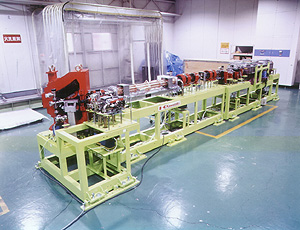World's First Pulse Electron Beam FIR-FEL Paves the Way for Pioneering Applications
May. 09, 2002

Kawasaki has developed the world's first pulse electron beam far infrared free electron laser (FIR-FEL) generator, in cooperation with the Tokyo University of Science. The unit was recently delivered to the IR FEL Research Center at the university's Noda campus, east of Tokyo. Full-scale trials of the FIR-FEL are scheduled to begin in October, with observations of laser light emissions anticipated by this fiscal year-end.
FIR-FEL, which is far more sensitive than X-rays and can "see" more selectively, operates in a spectrum that does not damage what is being examined. It could thus be used for an array of applications, including DNA and protein analyses and cancer detection. Applications are also anticipated in industry, research and envirometrics.
The laser at the IR FEL Research Center emits accelerated electrons at close to the speed of light using an RF gun (electronbeam generator) and an RF linear accelerator (linac). These electrons emit light when passed through a series of magnetic fields (undulator), which is then trapped in an optic resonator and amplified by adding the energy of the successive light emission to create laser light. By altering the strength of the electron energy and the magnetic field, the laser light wavelength can be manipulated between 300-1,000 µm, which lies within the wavelength band of far infrared.
Kawasaki's FIR-FEL generator is unique because it combines the linac with the RF gun, and features a much more compact laser, allowing the unit to be modularized and assembled in the factory. It can therefore be easily installed and set up in a relatively short period of time.
Kawasaki has been developing the FEL accelerator, which uses its proprietary technology, with the goal of finding industrial applications. In March 1998, a mid-infrared FEL (MIR-FEL) with a wavelength band of 4-16 µm was set up at the IR FEL Research Center for joint research on beam emission. In September 1999, Kawasaki successfully observed the light emission of a saturation laser, and active research is currently underway to find practical applications.
Based on the expertise acquired through the development and delivery of the FIR-FEL generator unit, Kawasaki is continuing to enhance the laser for expanded industrial applications, catering to a greater range of users and facilitating the creation of new IR-FEL industries.
[FIR-FEL Laser Performance]
Electron beam energy: 10 MeV
Wavelength tunability: 300-1,000µm





